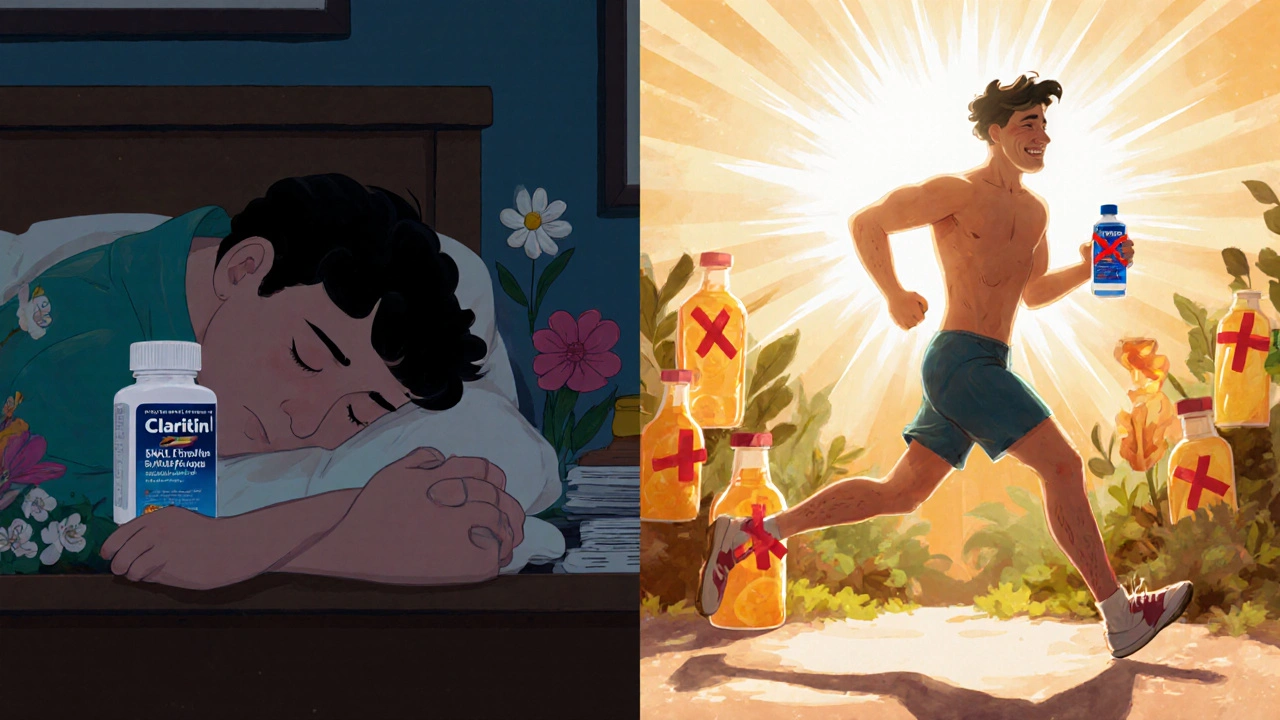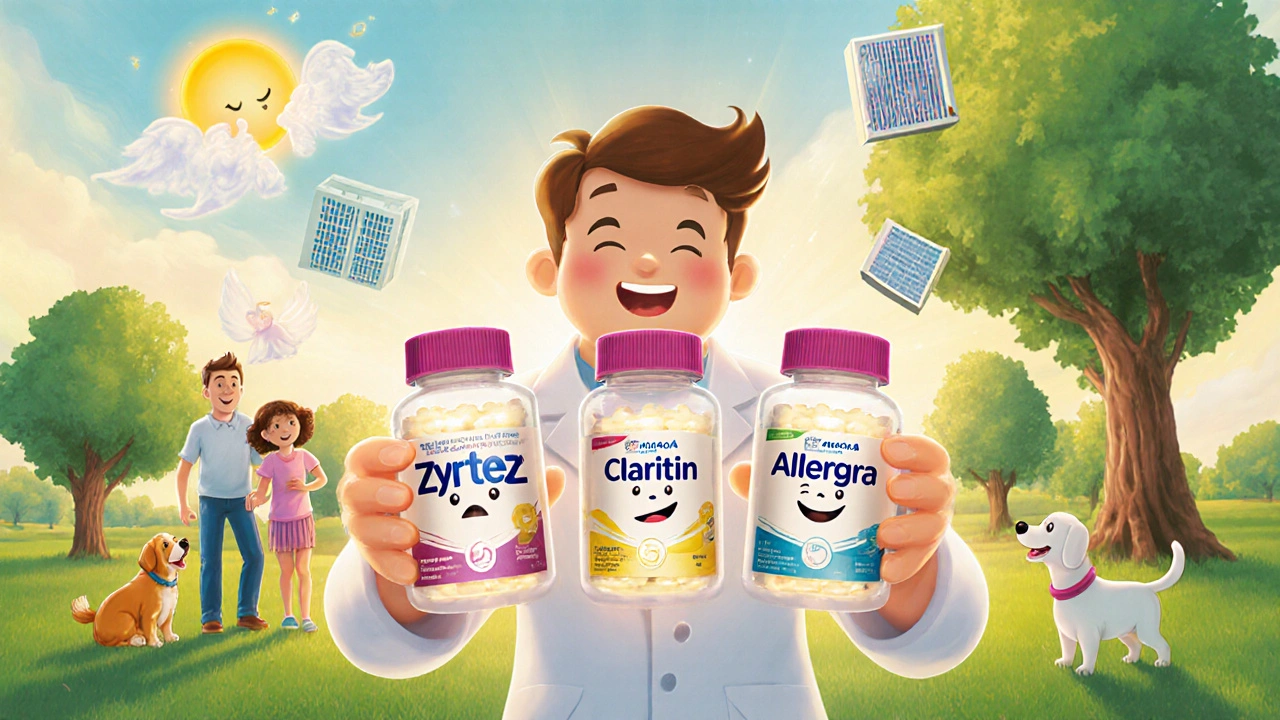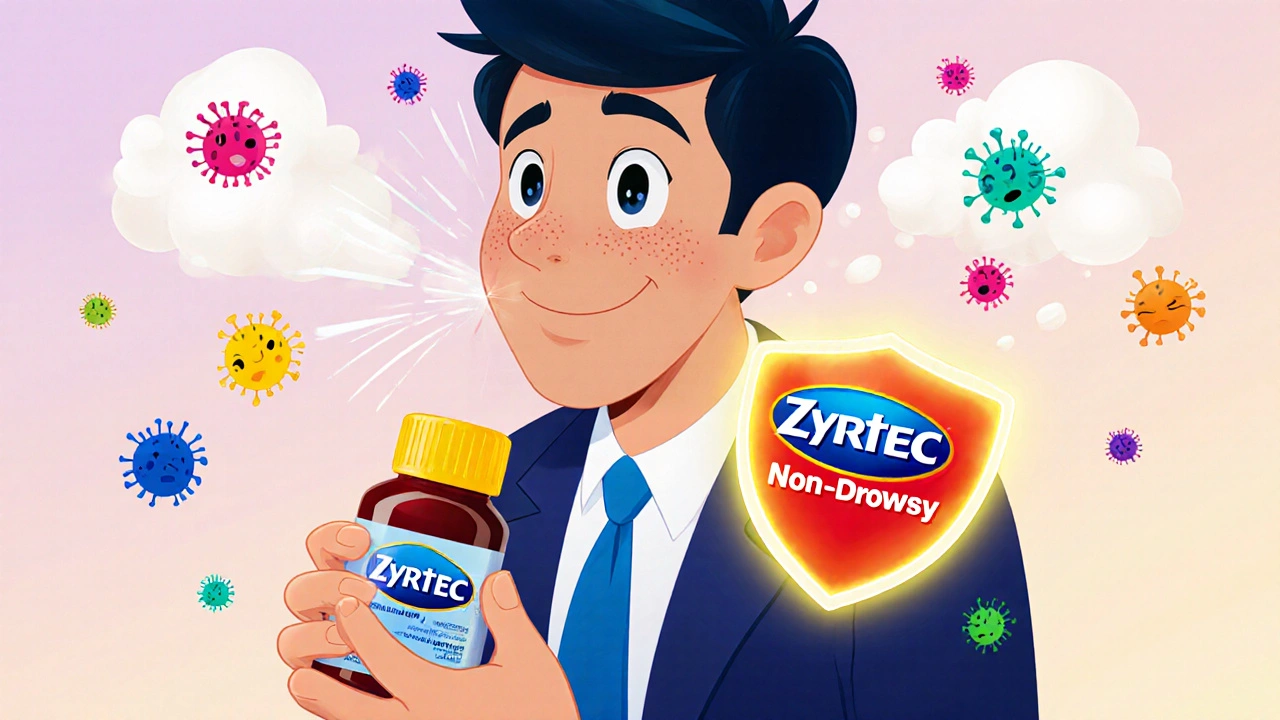Antihistamine Selector
Find Your Best Antihistamine
Answer a few questions to get a personalized recommendation based on 2025 clinical data.
Everyone knows the itch, the sneezing, the watery eyes - allergy season doesn’t care if you’ve got a big meeting, a shift at work, or a kid to pick up from school. First-generation antihistamines like Benadryl might knock out your symptoms, but they also knock you out. That’s why millions turn to non-drowsy antihistamines - but not all of them are created equal. In 2025, you’ve got a few solid options, each with different strengths, weaknesses, and hidden quirks. The goal isn’t just to find something that works - it’s to find the one that works for you, without making you sluggish, dizzy, or broke.
What Makes an Antihistamine Non-Drowsy?
Not all antihistamines are the same. The old-school ones - like diphenhydramine - cross the blood-brain barrier easily. That’s why they make you sleepy. They block histamine in your nose and eyes, sure, but they also hit receptors in your brain that control alertness. The newer ones - second- and third-generation antihistamines - were designed differently. They’re built to stay out of your brain. That means they stop the sneezing and itching without turning you into a couch potato.
This isn’t marketing fluff. Clinical studies show these medications have significantly reduced brain penetration. For example, fexofenadine (Allegra) barely crosses into the central nervous system at all, making it one of the safest picks for pilots, truck drivers, or anyone who can’t afford even mild drowsiness. Cetirizine (Zyrtec) does cross it a little more - which is why some people still feel a bit tired, even though it’s labeled “non-drowsy.”
The Top Three Non-Drowsy Options Compared
If you’ve ever stood in the pharmacy aisle staring at three nearly identical boxes - Zyrtec, Claritin, Allegra - you’re not alone. Here’s how they stack up based on real-world use and clinical data from 2025:
| Medication | Active Ingredient | Onset of Action | Duration | Drowsiness Risk | Food Interactions | Generic Price (90 tablets) |
|---|---|---|---|---|---|---|
| Zyrtec | Cetirizine | 1 hour | 24 hours | 10-15% of users | None | $10 |
| Claritin | Loratadine | 1-3 hours | 24 hours | 5-7% of users | None | $8 |
| Allegra | Fexofenadine | 1 hour | 12-24 hours | <5% of users | Avoid orange, grapefruit, apple juice | $12 |
Claritin is the slowest to kick in but the most consistent for mild symptoms. Zyrtec works fast and hits hard - great for sudden flare-ups, but if you’re sensitive, you might need to take it at night. Allegra is the quietest performer in terms of drowsiness, but if you drink orange juice with it, you might as well have skipped the pill.
Which One Works Best for Your Symptoms?
Not all allergies are the same. If your biggest problem is a runny nose and itchy eyes, all three will help. But if you’re dealing with stubborn nasal congestion, you might be disappointed. Antihistamines aren’t magic bullets for blocked sinuses. That’s where nasal corticosteroids like Flonase or Nasacort come in - they’re actually more effective for congestion and long-term control.
Here’s how to match the right antihistamine to your needs:
- Need fast relief? Go with Zyrtec. It starts working in about an hour. Ideal for sudden pollen spikes or pet exposure.
- Need all-day reliability without side effects? Allegra wins. It’s the most predictable and least likely to make you tired.
- On a tight budget and have mild symptoms? Claritin is the cheapest and still effective for most people.
- Have chronic congestion? Don’t rely on antihistamines alone. Pair them with a nasal steroid spray for real results.
And here’s a real tip from pharmacy staff in Leeds: if Zyrtec makes you groggy, take it at night. You’ll still get full 24-hour coverage, and you won’t feel it during the day. Most people don’t realize you can time it like that.

The Hidden Traps and Common Mistakes
People make the same mistakes over and over. Here’s what to avoid:
- Drinking juice with Allegra. Grapefruit, orange, and apple juice can cut Allegra’s absorption by up to 40%. Always take it with water. It’s not a myth - it’s in the prescribing info.
- Assuming “non-drowsy” means “no drowsiness.” About 1 in 10 people still feel sleepy on Zyrtec. That’s normal. It’s not a defect - it’s biology.
- Switching too fast. Give each antihistamine at least 3-5 days to show its full effect. Don’t quit after one dose.
- Using decongestant combos (like Claritin-D) daily. Pseudoephedrine can raise your blood pressure and make you jittery. Save these for short-term use only.
Also, don’t assume brand name is better. Generic cetirizine is chemically identical to Zyrtec. Same with loratadine and Claritin. You’re paying for the label, not the medicine.
What About Natural Alternatives?
You’ve probably heard about quercetin, butterbur, or local honey. These get talked up online, but here’s the truth: there’s no strong clinical evidence they work as well as FDA-approved antihistamines. Some small studies show quercetin might help stabilize mast cells (the ones that release histamine), but the doses needed are huge - and poorly regulated in supplements.
Local honey? It doesn’t contain the right kind of pollen to build immunity, and studies show no consistent benefit. Don’t waste your money.
If you want natural support, focus on what actually helps: air purifiers, HEPA filters, showering after being outside, and keeping windows closed during high-pollen days. These reduce exposure - which is better than just treating symptoms after they start.

When to Talk to a Doctor
Most people can safely try OTC antihistamines for months. But if you’re still struggling after 2-3 weeks of consistent use, it’s time to see a professional. Persistent symptoms could mean:
- You need a nasal steroid spray
- You have sinusitis or another condition mimicking allergies
- You’re exposed to something indoors - dust mites, mold, pet dander - that you haven’t addressed
Doctors can also do allergy testing. Knowing exactly what triggers you - whether it’s ragweed, cat dander, or cockroach particles - lets you target your environment instead of just medicating every day.
Final Advice: Try, Track, Tweak
There’s no single “best” non-drowsy antihistamine. What works for your coworker might leave you wide awake but still sneezing. The key is personal testing.
Here’s a simple plan:
- Start with the cheapest generic: loratadine (Claritin).
- If no improvement after 5 days, switch to cetirizine (Zyrtec).
- If Zyrtec makes you tired or doesn’t help, try fexofenadine (Allegra).
- Keep a quick log: date, symptom severity, side effects.
- After 3 rounds, you’ll know what works - or when to see a doctor.
And remember: cost matters. A $20 bottle of Allegra adds up over a year. Generic versions cut that in half - and work just as well. Pharmacies like Boots and Lloyds often have loyalty discounts, so ask.
Non-drowsy antihistamines are a huge upgrade from the old sleepy pills. But they’re tools - not cures. Use them smartly, know their limits, and don’t be afraid to adjust. Your nose - and your productivity - will thank you.
Can I take non-drowsy antihistamines every day?
Yes, all major non-drowsy antihistamines like cetirizine, loratadine, and fexofenadine are approved for daily, long-term use. They’re safe for most adults and children over 2 years old. But if you’re using them for more than 4-6 weeks without improvement, talk to a doctor - you may need a different approach, like a nasal steroid.
Why does Allegra need water and not juice?
Certain fruit juices - especially orange, grapefruit, and apple - contain compounds that block the transporter proteins in your gut responsible for absorbing fexofenadine. This can reduce how much of the drug enters your bloodstream by up to 40%. Water doesn’t interfere, so it’s the only safe option. This interaction is unique to Allegra - Zyrtec and Claritin aren’t affected.
Is Zyrtec stronger than Claritin?
In clinical trials, Zyrtec (cetirizine) tends to show slightly better symptom relief than Claritin (loratadine), especially for itchy eyes and sneezing. But Claritin is more consistent in causing zero drowsiness. Zyrtec works faster and stronger - but about 1 in 10 users feel sleepy. Claritin is milder but safer for people who need to stay alert.
Are generics as good as brand names?
Yes. Generic cetirizine is identical to Zyrtec. Generic loratadine is the same as Claritin. The FDA requires generics to have the same active ingredient, strength, dosage form, and bioavailability. The only differences are fillers, color, and price - and the price difference can be 50-80% lower. Save your money.
What if none of them work?
If antihistamines aren’t helping, your symptoms might not be from histamine alone. Nasal congestion often responds better to steroid sprays like Flonase. You might also have non-allergic rhinitis, sinus infections, or environmental triggers like mold or dust mites. See a doctor for allergy testing or a nasal exam - you might need a different treatment path.

Comments
Sophia Lyateva
lol so allegra doesnt work if you drink orange juice?? sounds like the pharma companies just made that up so we buy more pills 😂
On November 23, 2025 AT 07:31
David Ross
This is why America is falling apart... People think they can outsmart biology with cheap generics and juice tricks. The FDA doesn't care about your wallet, it cares about safety. If you're taking Zyrtec and still sneezing, you're probably allergic to your own laziness. Get a nasal spray. Or move to Alaska.
On November 23, 2025 AT 07:50
Craig Ballantyne
The pharmacokinetic profile of fexofenadine is indeed characterized by minimal CNS penetration due to P-glycoprotein efflux at the blood-brain barrier. However, the clinical significance of juice interactions remains underappreciated in primary care settings. A 40% reduction in bioavailability is clinically meaningful-particularly in patients with polypharmacy or renal impairment.
On November 23, 2025 AT 23:51
Lyn James
Let me tell you something about the pharmaceutical-industrial complex. They don't want you to know that local honey works better than any of these chemicals. The FDA is in bed with Big Pharma. They suppress natural remedies because they can't patent them. You think they care about your allergies? No. They care about your monthly subscription to Zyrtec. Wake up. The truth is hidden in plain sight. Read the fine print on the bottle. It says 'for temporary relief.' That's because they know it's not a cure. It's a trap. And you're paying for it. Every. Single. Month.
On November 25, 2025 AT 07:30
Nicholas Swiontek
I tried all three over three seasons. Claritin was fine for mild stuff, Zyrtec crushed it but made me a zombie, and Allegra was the sweet spot. Pro tip: take it with water. And yeah, generics are the same. Saved me like $300 a year. You're not weak for needing help-you're smart for finding what works. 💪
On November 25, 2025 AT 08:57
AARON HERNANDEZ ZAVALA
I get what you're saying about juice and Allegra but I've had orange juice with it for years and never noticed anything. Maybe it's just me. I think everyone's body reacts differently. I don't think we should scare people off things without more proof. Maybe it's not the juice, maybe it's something else. I just want people to feel heard, not judged.
On November 25, 2025 AT 23:56
Victor T. Johnson
If you're still using OTC antihistamines after 3 weeks you're not trying hard enough. The real solution is eliminating your environment. Wash your sheets weekly. Use a HEPA filter. Get rid of your cat. Stop pretending your allergies are 'natural.' They're a symptom of your poor lifestyle. I've been pollen-free for 5 years. All it took was discipline. And maybe a little bleach. 🧴
On November 26, 2025 AT 03:28
Robert Asel
The assertion that generic loratadine is bioequivalent to Claritin is statistically valid under FDA guidelines, yet the variability in excipients may introduce pharmacodynamic differences in sensitive populations. Furthermore, the claim that 'no drowsiness' means 'no sedation' is a semantic fallacy; clinical trials report subjective drowsiness in up to 15% of cetirizine users, which constitutes a significant adverse effect profile. One must consider individual pharmacogenomics, particularly CYP2D6 polymorphisms, before recommending any agent as universally 'safe.'
On November 28, 2025 AT 00:45
Shannon Wright
I want to say thank you for writing this. I’ve been struggling with allergies for years and felt so alone in this. I tried everything-natural remedies, expensive brands, even acupuncture. Nothing worked until I started tracking symptoms like you suggested. I switched from Zyrtec to generic fexofenadine, took it with water, and now I can actually work without feeling like I’m drugged. It’s not magic. It’s science. And you made it feel doable. For anyone reading this: you’re not broken. You just haven’t found your system yet. And that’s okay. Take your time. Be kind to yourself. You’re doing better than you think. 🌿❤️
On November 29, 2025 AT 22:13